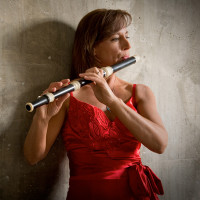by Jeremy Reynolds

In a recent phone conversation, baroque flutist Kathie Stewart shared her thoughts on keeping Bach’s Brandenburg fresh. “We’ve done it lots of times, and there’s no one I enjoy playing it with more than Olivier Braut (violin) and Jeannette Sorrell (harpsichord). We’ve really worked it out in a way that’s comfortable for us. It’s just such great music! It’s the most beautiful piece ever — it’s so life-affirming,” she said. “He wrote it in the best key possible for the flute — not that he was thinking of that — but he put it in D Major, which is the natural key of the baroque flute. It’s idiomatic. In fact, it’s probably the only piece he ever wrote that’s idiomatic for the flute. So it’s a joy to play and it feels good. I never get tired of it.”
How do the baroque and modern flutes differ from one another? “The baroque flute is made of wood, and it only has one key, instead of however many million keys the modern flute has,” she said. “And so it has a softer, mellower sound. It’s fully chromatic, but it doesn’t quite have the range of the modern flute. Otherwise we can do everything the modern flute can, we just have to work harder at it.”
Stewart, who curates Oberlin Conservatory’s harpsichord collection and maintains a private studio in addition to performing with Apollo’s Fire, explained that the cheerful concerto was the first piece that Bach wrote to feature the flute as a solo instrument, but that the flutist must share the spotlight.
“When you see the piece performed, you think it’s going to be a flute concerto because the flutist stands in the middle of the orchestra and waits while the group plays the opening ritornello,” she said. “But then when the flute enters, it’s not a solo — it’s a big trio. Really, the main feature is the harpsichord, and the flute and violin just help out. So you think it’s going to be a concerto, but — surprise! I can just see Frederick the Great starting to play and then saying, ‘Hey, why are you playing during my concerto? Shut up!’”
Not only is the Brandenburg Bach’s first large-scale work for flute, but, according to Stewart, it is also the first piece to feature the harpsichord in a non-continuo role. “The harpsichord traditionally just chugs along playing continuo, but of course by the end of the piece it completely takes over. That’s the other interesting thing about the fifth Brandenburg — it’s the first real harpsichord concerto.”
A far cry from the sunny concerto, the Trio Sonata from A Musical Offering is in a far moodier c minor, a particularly difficult key for the baroque flute. “It’s the opposite extreme of Bach writing for the flute,” Stewart said. “Remember how D Major is the flute’s natural key? Well this is in c minor! It’s a horrible key for the baroque flute, just nasty. Bach wrote this very dark, complicated piece, and he explores the theme in some really convoluted ways. I don’t know if he decided that he didn’t like flute players between the fifth Brandenburg concerto and the trio sonata. They are both extremely beautiful pieces, but the Trio Sonata is very, very difficult.”
Stewart explained that A Musical Offering was written just over a quarter of a century after the Brandenburg as a challenge from Frederick the Great. “Towards the end of Bach’s life, he went to visit his son, Carl Philip, who was working in the court of Frederick the Great,” Stewart recalled. “And of course, Frederick had heard all about Johann, and the king gave Bach a melody, challenging the composer to improvise a three-voice fugue. Which he did. So then Frederick said, ‘Now improvise a six-voice fugue!’ And Bach declined, saying that he needed more time to do the melody justice. So he took his time and composed a collection of fugues called A Musical Offering. And in the middle of those there’s this one Trio Sonata, and that’s what we’re going to play.”
Although she won’t appear in Telemann’s Canary Cantata, the flutist laughed as she recounted the tragicomedy’s origin. “There’s a funny piece that I don’t play in about the death of a canary. It reminds me a little bit of Bach when he wrote the Coffee Cantata. Telemann took a very ordinary subject and wrote this grand music about it. It’s about someone who had a very beloved canary, and the cat got the canary. The canary had sung the very best songs in the world — but no more.”
Apollo’s Fire makes regular appearances at the Baroque Music Barn, which Stewart likened to the Coffee-Gardens in Leipzig. “Telemann started a series in the Coffee-Gardens, and when he left, Bach took over. The Baroque Music Barn has beautiful acoustics. Ordinarily, I play in the crossover concerts, which feature a mixture of baroque and folk tunes. This is the first time I am playing a strictly baroque concert there. It’s all wood, so it’s got a lot of reflective surface. It’s more or less an outdoor venue with a roof — very rustic. Playing in the barn is one of my favorite things to do in the summer.”
Published on ClevelandClassical.com June 9, 2015.
Click here for a printable copy of this article



